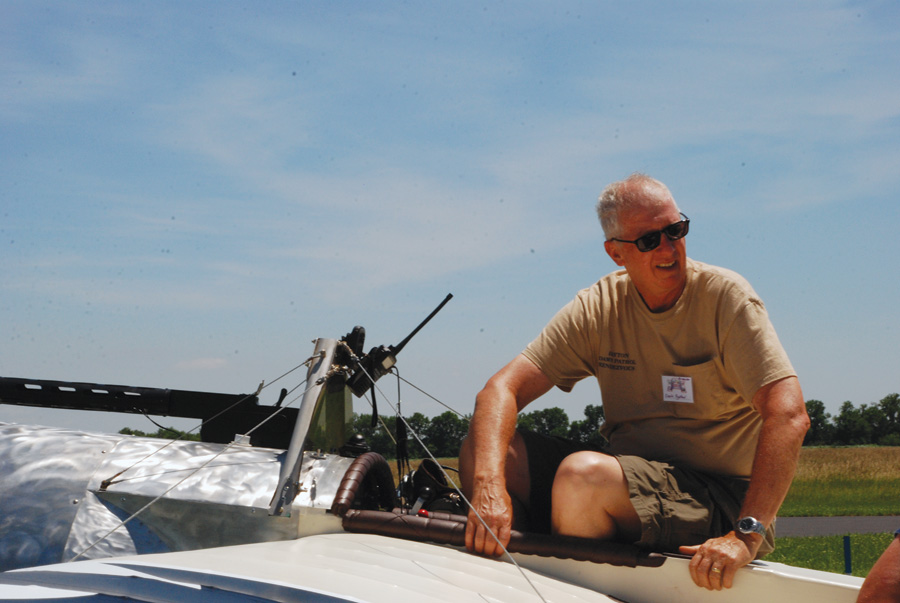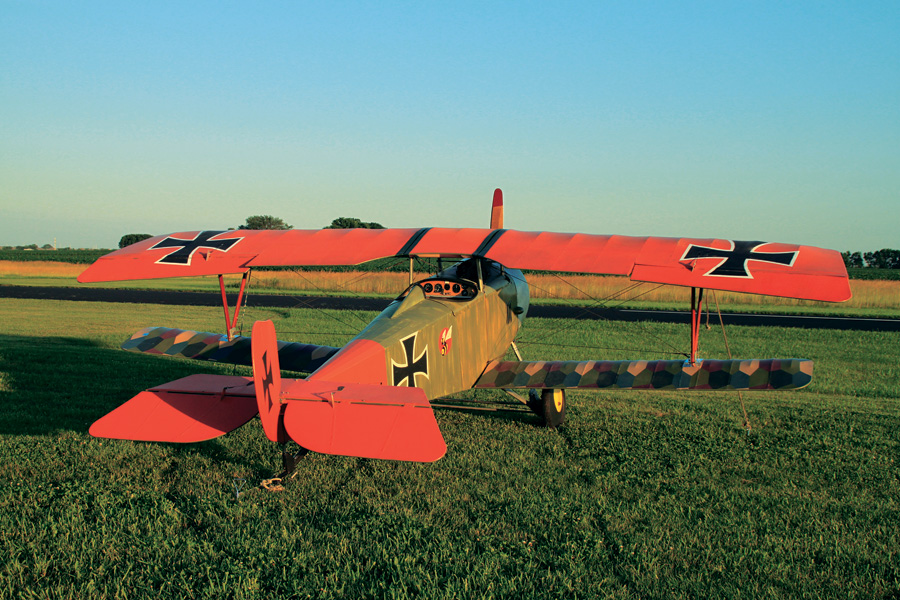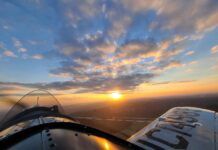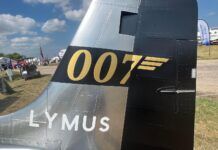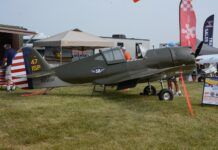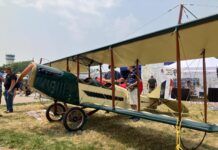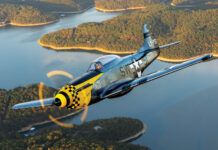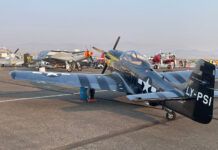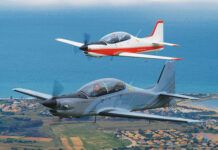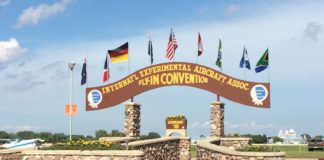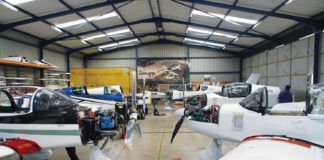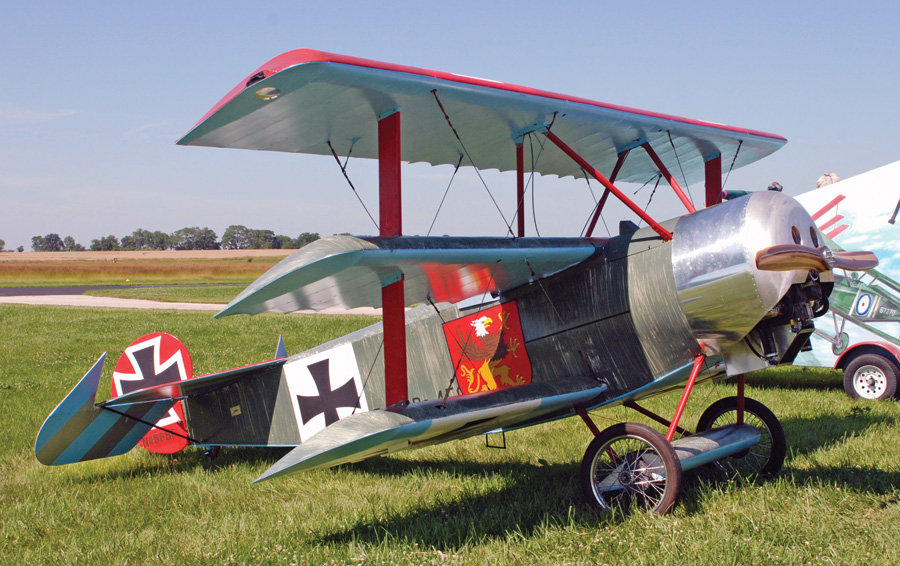
Dustin Burt’s outstanding Airdrome Aeroplanes Fokker Triplane. It is painted in a modified Richthofen scheme similar to the image in a painting by the talented aviation artist Russell Smith.
Just as soon as my wheels left the ground I knew I’d made another big mistake. “Oh man, I’m sure sorry I just did that!” I muttered to myself.
For the stalwart men (and woman) in the Kansas City Dawn Patrol, our usual preferred flight conditions are severe clear with winds zero, gusting to two. Crosswinds over 5 mph are considered iffy for flying. Crosswinds over 10 are a no-go situation. It’s even nicer with temperatures below 80 degrees. You know, of course, this is a hobby—it’s not a job! We fly for fun. Why should we fly when it won’t be fun?
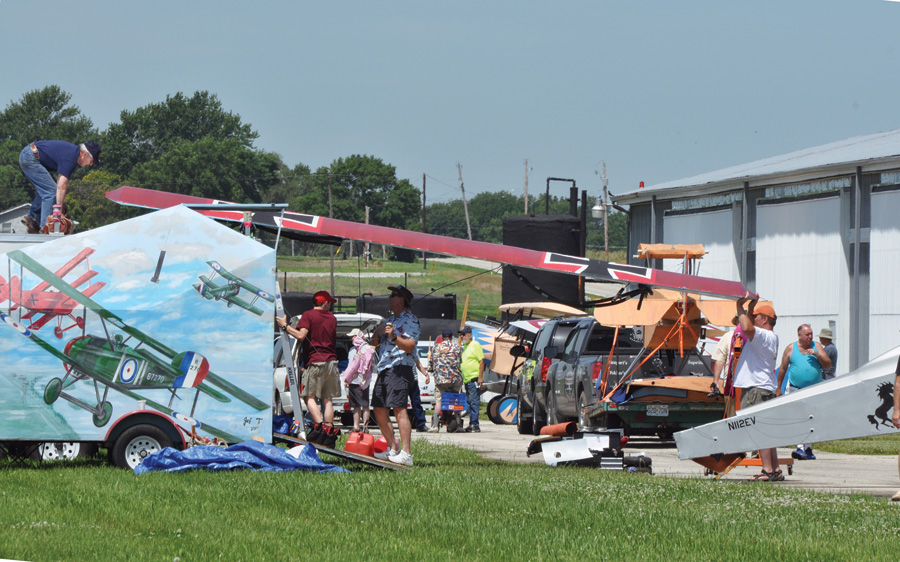
Action in the pits: If you look real close, you can see five planes being assembled. (Photo: Bob Punch)
Which therefore begs the question: What in the world was I doing flying in winds that were gusting to over 30 mph? Inquiring minds wanted to know. Normally we wouldn’t even open the hangar doors on days like this. Heck, with winds forecast to be over 20 mph, we wouldn’t even go to the airport.
Well, this was a different type of day. We were at a special event for WW-I pilots and aircraft. It was the annual Gathering of Eagles held over the Father’s Day weekend at the Gardner, Kansas, Municipal Airport. It was not so much an airshow as a time for WW-I builders and flyers to gather, see what’s new, check out different planes, and look at some construction on uncovered aircraft. Prospective builders will show up from all over the country to see the planes fly, talk to the pilots, sit in the cockpits, look at engine options, and talk to builders and kit suppliers. Usually some new replicas or projects in process show up, too.
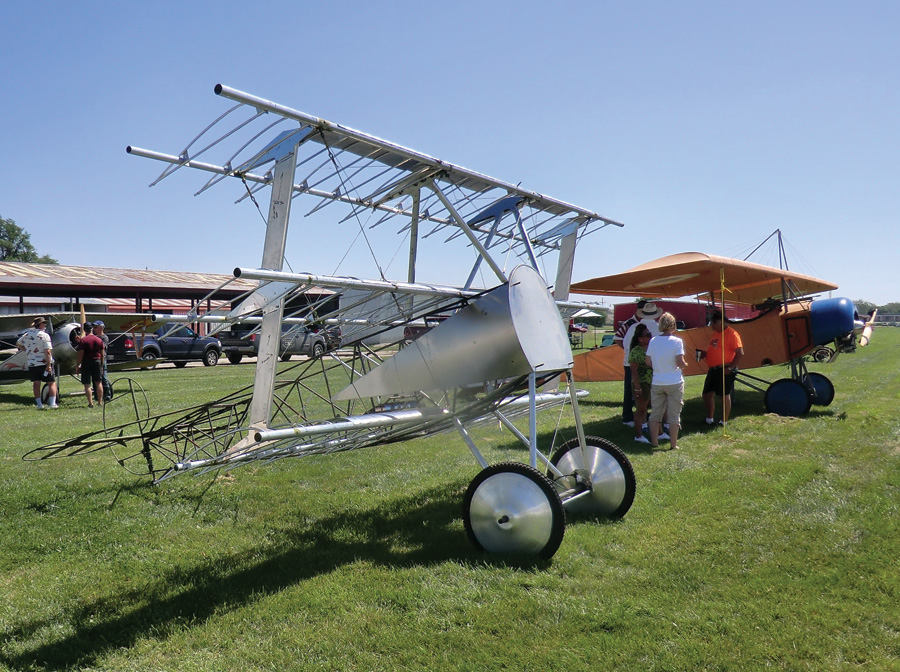
Robert Baslee’s 7/8th-scale Fokker DR-1 Triplane with his full-scale Morane Parasol in the background.
It’s at events like The Gathering of Eagles and other airshows that our normal rules for the operation of our twitchy little always-ready-to-bite-you-on-the-butt taildraggers are sometimes, unwisely I might add, ignored.
Hiding deep in the murky depths of our wannabe fighter-pilot psyche is the real reason we fly these “suicide missions” in impossible weather conditions.
It’s simple—we like showing off our little warbirds to crowds of people. Showing other pilots, particularly non-taildragger pilots, that you’ve mastered the intricate, demanding, highly skilled art of flying a tailwheel aircraft is a feeling of accomplishment few pilots get to enjoy these days. Besides that, nothing in the world gives you the ego boost that you get when taxiing back up to the flight line in front of a crowd.
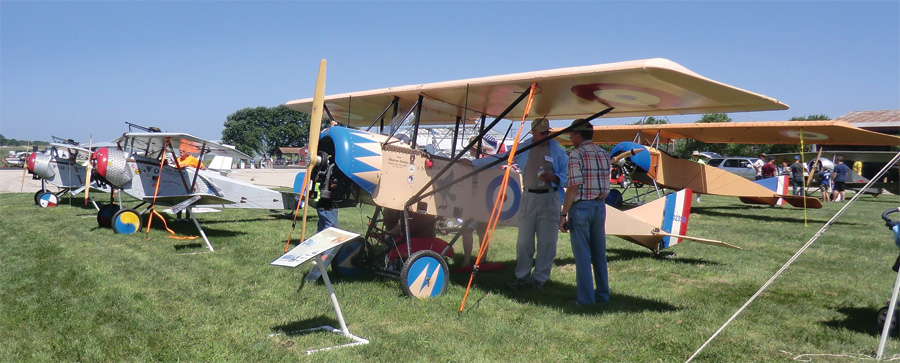
Sharon Starks’ Airdrome Aeroplanes Morane-Saulnier “L” Parasol. Parasols are great sun shields. The problem with most biplanes is you can’t sit in a chair under the wings. Dick Starks’ 1986 Graham Lee Nieuport 11 replica is in the background.
With a smug smile plastered on your face, while your white silk scarf is snapping in the slipstream, you can sit casually in the cockpit with your goggles up on your forehead. Rolling down the flight line with your elbow on the edge of the cockpit, you can give casual waves to the cheering crowd. However, you do have to remember the hoary old taildragger mantra: You ain’t through flying ’til the tiedown ropes are on. A little inattention waving at the crowd while taxiing in can have you dragging a wingtip on the ground in less time than it takes to read this sentence. The crowds just love seeing that!
The Gathering is always the Friday and Saturday of Father’s Day weekend. The planes arrive on Friday, mostly by trailer, get assembled, and fly all day Friday. Saturday starts early, and we fly all day long ’til about 4 or 5 p.m., then put them back on their trailers and trudge on home. It’s an intense two days, too. There’s no set program, so anyone that wants to fly can fly as much as they want. Some builders trailer their unfinished projects in, just to get some ideas and guidance from pilots with assembled planes. Many photos of certain parts of the finished planes are taken. The pilots’ brains are picked to get hints on assembling, covering, painting, and flying the planes.
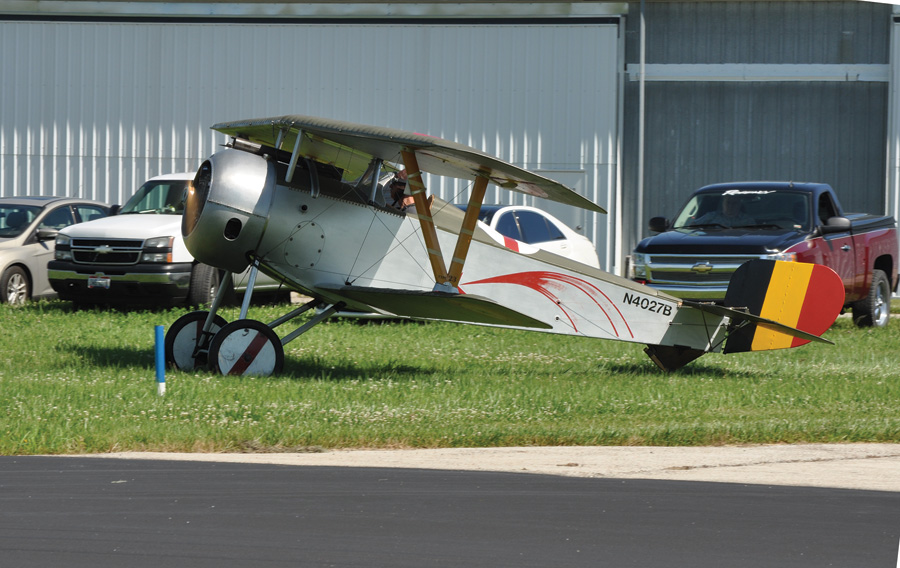
Rick Bennett’s incredible Graham Lee Nieuport 23 replica. Rick is a purist, and his plane has a tailskid, not a tailwheel.
The weather Friday was pretty good. The light wind was out of the north, so the big wide 3200-foot grass Runway 17/35 was favored. Flying off that beautiful long green expanse is pure heaven. Grass is much more forgiving on these twitchy little waterbugs than pavement.
And, as usual, Robert Baslee of Airdrome Aeroplanes didn’t disappoint. He always brings a new design to Gardner. Last year it was his very impressive full-scale SE-5A. The plane had just returned from out west in the desert, flying in the movie, Out of the Burning Blue. Also being flown in the movie was one of Robert’s full-scale Fokker DR-1 triplanes.
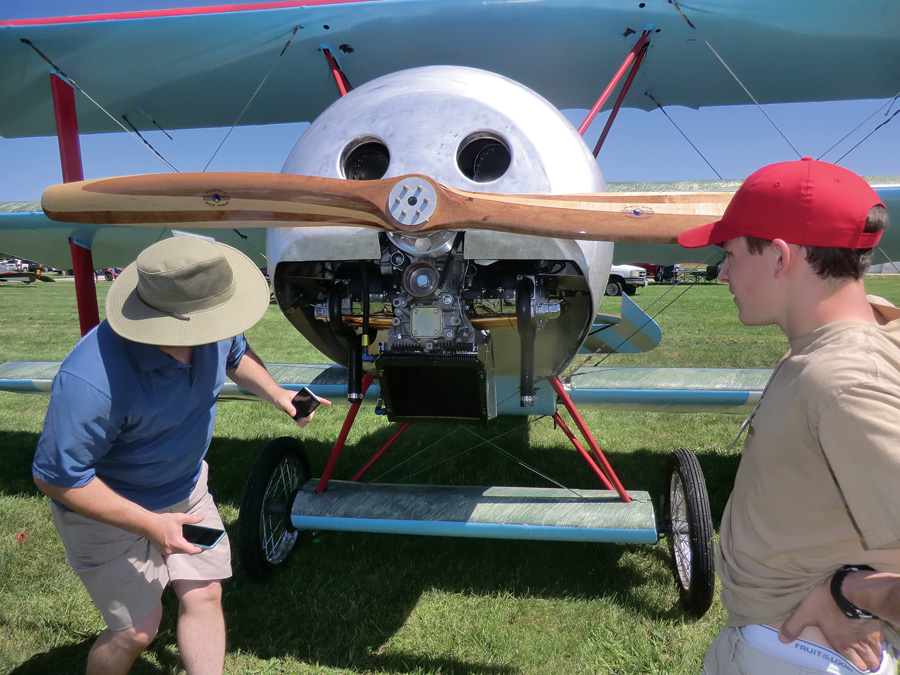
Dustin Burt’s Airdrome Aeroplanes Fokker Triplane features a Valley Engineering 2332cc VW and PSRU, with a Culver prop.
Well, this year Robert showed up with two new designs. One was a very impressive full-scale replica of the Morane-Saulnier “L” Parasol. Just like my Sweetie’s, but a lot bigger. The power options are a VW with PSRU, Rotec Radial, Continental A-65, -75, -85 or equivalent.
Robert’s other fresh design was his new 7/8th-scale Fokker DR-1. It could also use the same powerplant options as the full-scale Morane (except for the heavier Rotec Radial.)
The turnout this year was down a little, mostly because of the horrible weather forecast for Saturday. Typical hot, humid Kansas weather in June is a given. We always expect that. But wouldn’t it be nice if for just once, we could get some quality flying in both days of the fly-in? Again, it was not to be. The forecast for Saturday was for miserable hot and humid conditions. (Well, duh…Kansas in June.) But winds gusting to over 30 mph were the unwelcome ingredient in the mix that kept all of the fly-in traffic from making the trip—except one. Harvey “Hollywood” Cleveland was there in his 1918 Curtiss Seagull replica.
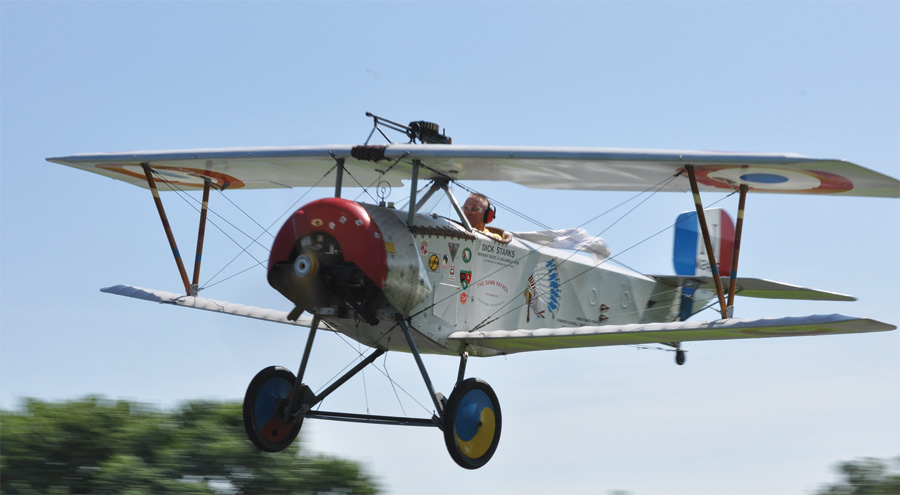
Dick Starks making a pass in his 1986 Graham Lee Nieuport 11 replica. Valley Engineering direct-drive 2010cc VW with Culver prop. The bullet hole decals came from a Harley shop. (Photo: Bob Punch)
On Friday, everyone who could get his or her plane together and in the air flew all day long. Sweetie and I made a lot of formation passes down the flight line for the many photographers lining the runway. It was just swell! Finally, as the day was wearing down, planes were tied down securely for the long windy night.
Saturday dawned already hot and windy. As we drove up to the flight line, there was a lone plane in the air. It was Mark Hymer in his gorgeous Airdrome Aeroplanes Fokker D-7. Mark’s D-7 is painted in the colors of German ace Ernst Udet. With its Air Trikes Suzuki engine package, it is a real showstopper. It’s also a great flying plane. It is rapidly becoming one of Robert’s most popular kits.
We were waiting as Mark taxied up and shut down his engine. He looked at me and shook his head. “It’s just horrible up there,” he said. “The turbulence is just about all I could handle. I really don’t recommend going up.”
Now Mark’s a really good stick. To hear his honest opinion of the flying conditions was real sobering news and not to be taken lightly.
Sweetie and I just stood there. After all the fun we’d had flying on Friday, we were ready for some more.
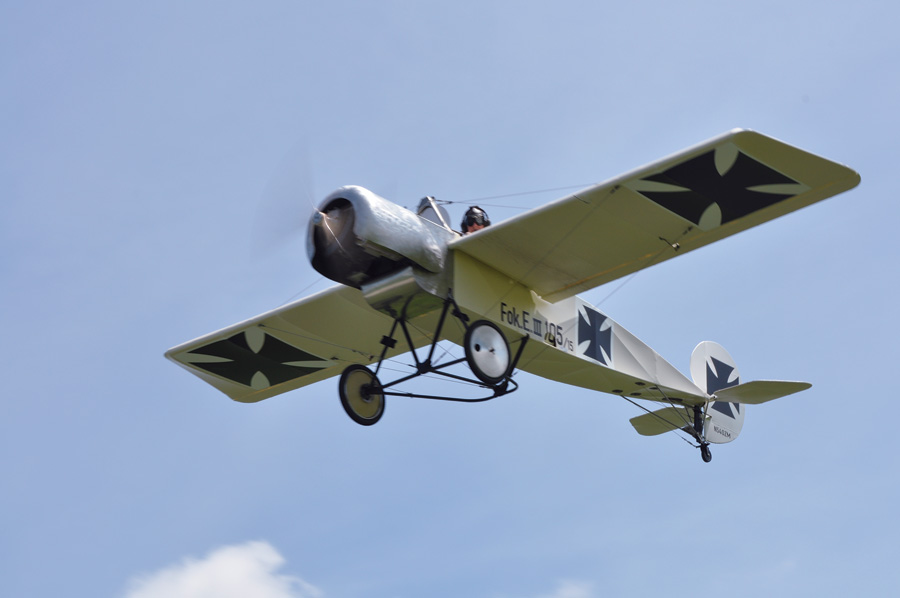
Radford makes a pass down the flight line. The Fokker E-III replica is powered by a Rotax 503 engine.
The gusty hot wind was singing high wailing notes in the power lines behind us. Hangar doors were rattling. Flags were snapping like coach whips. Some of the gusts would actually push you back if you were facing into the wind.
But…it was right down the runway! It couldn’t have been any more centered down that beautiful 3200- by 90-foot grass strip if a surveyor had laid it out.
I couldn’t stand it. There was a big crowd standing around looking for some action. I decided to give them some. I started untying the tiedown ropes on my Nieuport.
Sharon came thundering over to me with fire in her eyes. “You’re not going up in this are you?”
“Yep…It’s bump dummy time.”
“If you go up in this wind you’re just a plain dummy!” she retorted. (She seemed upset.)
“But Dear, it’s right down the runway! I can’t pass this up. I want to go! Please can I go? Can I? Can I? Please, it’s right down the runway!”
“You’re outta your simple one-cell mind!” she replied.
I just kept on untying ropes and getting my bird ready to go. I looked at Sweetie and said in my deepest manly voice, “You know Sweetheart…sometimes a man’s gotta do what a man’s gotta do.” (The Duke said it much better, I’m sure!)
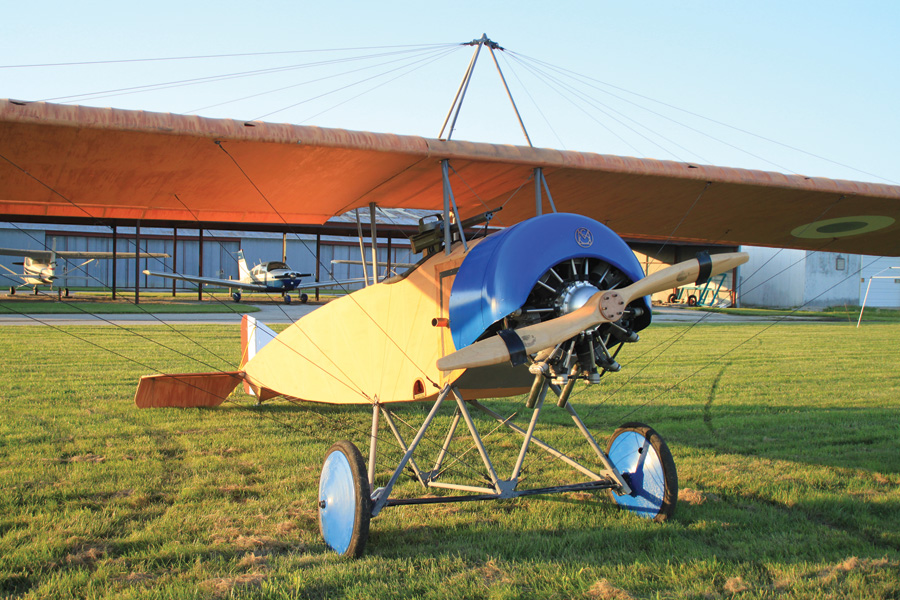
Robert Baslee’s Airdrome Aeroplanes full-scale Morane-Saulnier “L” Parasol. Note the steel bullet deflectors on the prop.
She looked steadily at me for a long couple of seconds…”You are such an idiot.” (However, I’m pretty sure it was said in a loving way.)
But, since I was her idiot, she did help me untie the rest of the tiedowns. And she did help me put on my seat belt and shoulder straps. All the time, she was muttering threats in my ears.
My engine started with its usual snorts, gurgles, farts, cloud of smoke, and complaints. After the pistons quit changing holes and she’d settled to her normal throaty idle, I started off. We taxied down to the end of Runway 17. The gusty winds did make taxiing a challenge. A few times the plane weathercocked into the wind when a particularly savage gust hit us.
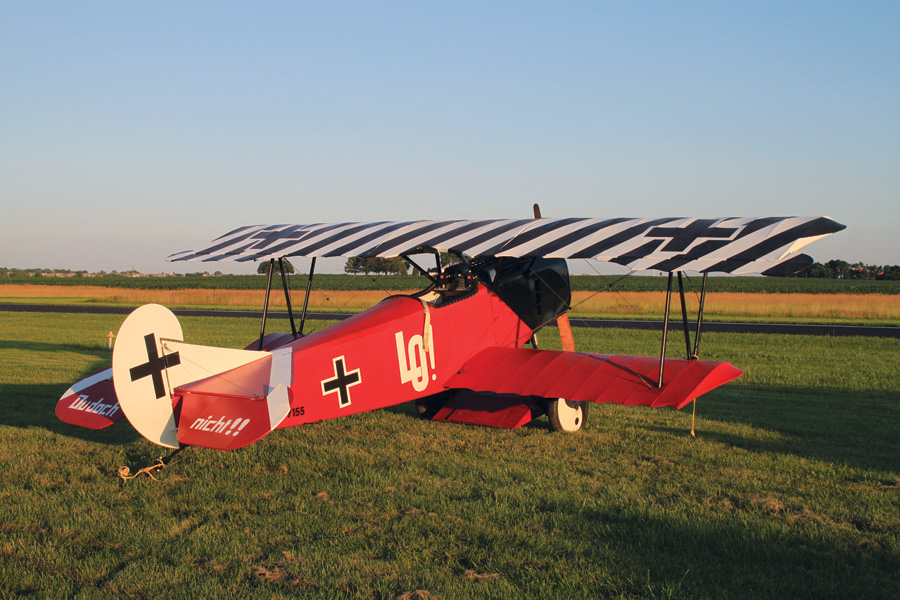
Mark Hymer’s 7/8th-scale Fokker D-7 replica is painted in the colors of the D-7 flown by German ace Ernst Udet.
Reaching the end of 17, I got ready to go. Lining her up on the centerline of the runway, I took stock of the situation. The wind was rocking the wings like a giant was on each wingtip yanking them up and down.
By then I was trying to think of an honorable way to walk away from this without looking like a total wuss. There was no way to back away from this. It was hero or goat time. I went through my pre-takeoff checklist:
Check seat belt and shoulder straps really tight…Check!
Check grip on seat cushion… Check! (Even if the plane turned upside down and my straps weren’t on, I wasn’t going to fall out.)
Check fuel on…Check!
Check controls free…Check!
Check traffic…Yeah, right…No other idiots were out there in these hellacious conditions.
Checklist complete, I was ready to go.
I was still thinking of a way to honorably back out of the whole deal when I thought, I know what Jack Reacher would do if he were me!
With a snarl on my lips and slitted eyes, I firewalled the throttle. The Gray Falcon bellowed in rage and surged forward.
Yee-haw! Away we went.
We were off the ground in about 100 feet. As soon as the wheels left the ground, I got hit by a gust that told me I’d just made a serious mistake. The hell with Jack Reacher, he wasn’t flying a WW-I Nieuport fighter!
Mark Hymer was right—it was horrible! I’d only gained about 20 feet of altitude when I got hit by a gust that took all the aileron I had plus a frantic “Nieuport stomp” on the rudder bar to keep me from going into the wheat field beside the runway.
I kept going as straight-ahead as I could until I reached a couple of hundred feet of altitude, then I started the crosswind turn.
The next 15 or 20 minutes were bone-chilling scary, punctuated with periods that were outright horrifying. Now, some people might have thought I was the head stud of the air staying up as long as I did that day, but they would be wrong. I was simply trying to get my nerve up to attempt a landing! The turbulence was unreal, the worst I’ve even flown in. There were several times when it took full aileron and full rudder to keep her upright.
Four times I set up a long approach to 17, only to abort the attempt because of the turbulence. On about my fifth approach I said, “The hell with it!” and decided to get it done. Fighting stick and rudder, I lined up with the centerline and headed in carrying 10 to 15 mph extra airspeed on short final.
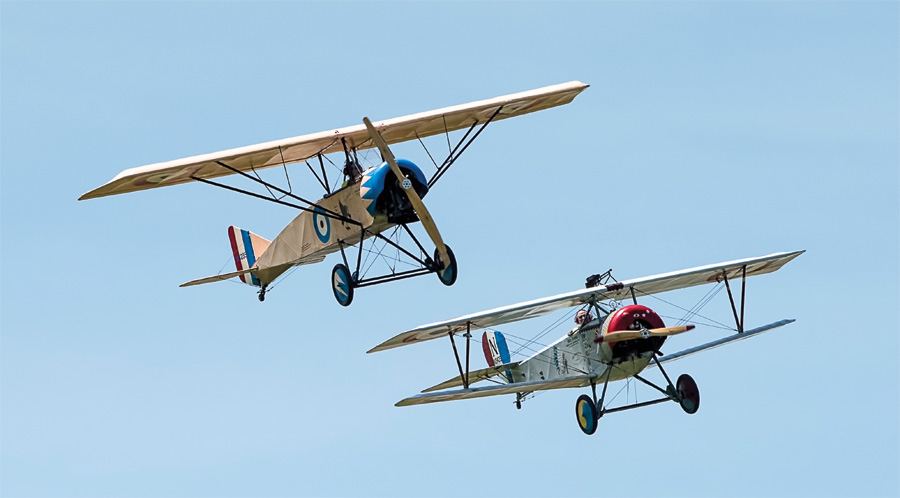
Sharon Starks in her Airdrome Aeroplanes Morane-Saulnier “L” Parasol and Dick Starks in his Graham Lee Nieuport 11 make a pass down the line on Friday when the weather was good for flying. (Photo: John Crisp)
The landing wasn’t pretty, but nothing fell off the plane. Of course, when you’re landing at 40 mph into a 30 to 35 mph headwind, your groundspeed is only about walking speed. My landing rollout might have been 50 feet.
I carefully taxied back to the flight line, lined her up, and shut down the engine. I did not wave to the crowd while doing this. Sharon came up, looked at my pale face and staring eyes. “Well…how was it?”
I couldn’t answer her at first. My mouth was so dry I couldn’t spit. My pucker factor was still in the red zone as I was still trying to let go of the death grip I had on the seat cushion.
“Don’t go up!” I finally gasped to her. “You were right. This was really stupid. We’re done here. It’s time to take them apart and go home.”
The winds were so high by this time that we had to hide our planes in the lee of the line of hangars at the airport to take them apart. It took four helpers hanging on to walk them behind the row of hangars where we put them on their trailers.
But, it all went well. We got the birds back to Liberty Landing International Airport with no problem. The planes were put back together, and the normal laidback summer afternoon flying could begin.
Another typical Gathering of Eagles was over. Once again, even considering the usual Kansas weather, it had been a great success.
This adventure will continue this June!
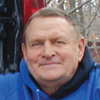
![]()
Dick Starks has written two books about the joy of flying; “You Want To Build And Fly A What?” and “Fokkers At Six O’clock!!” He was the recipient of Flying’s 2001 Bax Seat Award “for perpetuating the Gordon Baxter tradition of communicating the excitement and romance of flight.” Dick and his wife, Sharon, both fly WW-I replica aircraft.


